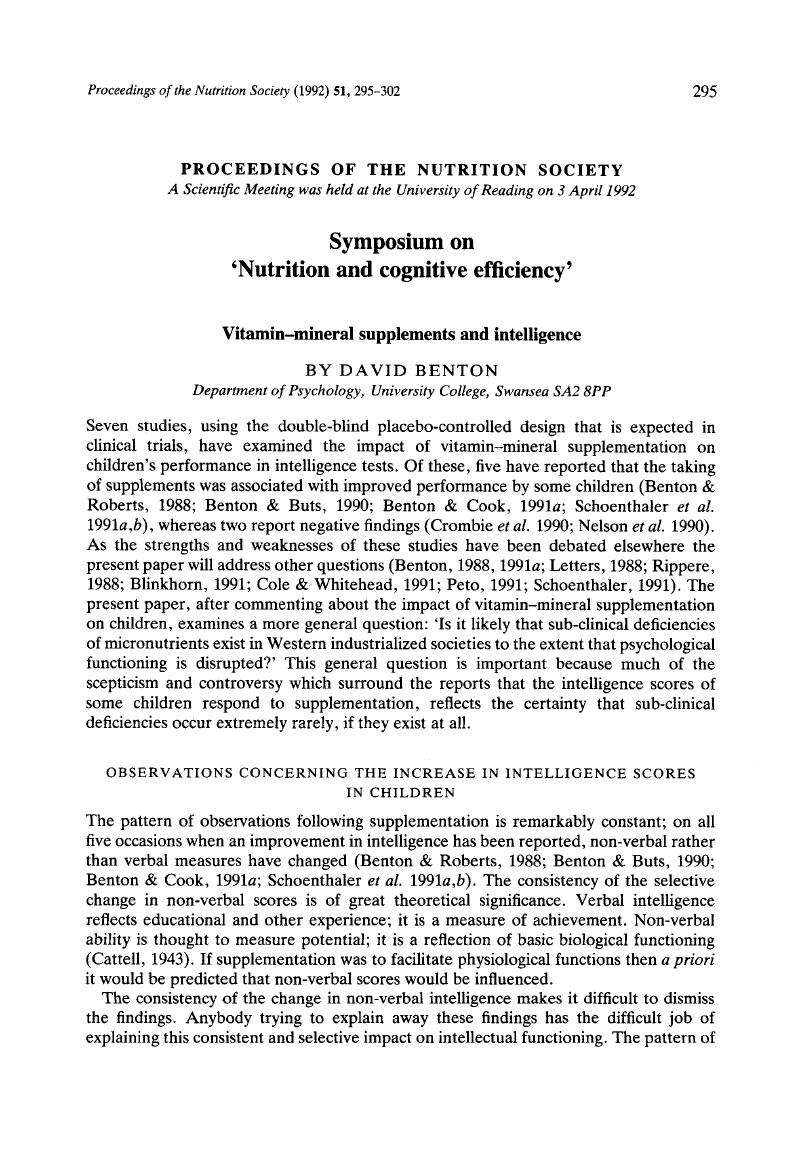Crossref Citations
This article has been cited by the following publications. This list is generated based on data provided by Crossref.
Bsc, Rebecca Griffiths
and
Phd, David Benton
1994.
Impact of Vitamin/Mineral Supplementation on the Attention and Intelligence Scores of an 8-Year-Old Boy.
Journal of Nutritional Medicine,
Vol. 4,
Issue. 1,
p.
87.
Evans, Peter H.
1994.
Nutrient and toxin interactions in neurodegenerative disease.
Proceedings of the Nutrition Society,
Vol. 53,
Issue. 2,
p.
431.
Bates, C. J.
Evans, P. H.
Allison, G.
Sonko, B. J.
Hoare, S.
Goodrich, S.
and
Aspray, T.
1994.
Biochemical indices and neuromuscular function tests in rural Gambian schoolchildren given a riboflavin, or multivitamin plus iron, supplement.
British Journal of Nutrition,
Vol. 72,
Issue. 4,
p.
601.
Benton, David
1995.
Do Low Cholesterol Levels Slow Mental Processing?.
Psychosomatic Medicine,
Vol. 57,
Issue. 1,
p.
50.
Benton, D.
Fordy, J.
and
Haller, J.
1995.
The impact of long-term vitamin supplementation on cognitive functioning.
Psychopharmacology,
Vol. 117,
Issue. 3,
p.
298.
Eastwood, Martin
1997.
Principles of Human Nutrition.
p.
485.
Riedel, Wim J.
and
Jorissen, Brenda L.
1998.
Nutrients, age and cognitive function.
Current Opinion in Clinical Nutrition and Metabolic Care,
Vol. 1,
Issue. 6,
p.
579.
Bellisle, F.
Blundell, J. E.
Dye, L.
Fantino, M.
Fern, E.
Fletcher, R. J.
Lambed, J.
Roberfroid, M.
Specter, S.
Westenhöfer, J.
and
Westerterp-Plantenga, M. S.
1998.
Functional food science and behaviour and psychological functions.
British Journal of Nutrition,
Vol. 80,
Issue. S1,
p.
S173.
Benton, David
and
Donohoe, Rachael T
1999.
The effects of nutrients on mood.
Public Health Nutrition,
Vol. 2,
Issue. 3a,
p.
403.
Benton, D.
2001.
Micro-nutrient supplementation and the intelligence of children.
Neuroscience & Biobehavioral Reviews,
Vol. 25,
Issue. 4,
p.
297.
Tomkins, Andrew
2001.
Vitamin and mineral nutrition for the health and development of the children of Europe.
Public Health Nutrition,
Vol. 4,
Issue. 1a,
p.
91.
Benton, David
2002.
Diet - Brain Connection.
p.
15.
Benton, David
2005.
Can functional foods modify mood?.
Food Science <html_ent glyph="@amp;" ascii="&"/> Technology Bulletin: Functional Foods,
Vol. 2,
Issue. 5,
p.
49.
Skalicky, Anne
Meyers, Alan F.
Adams, William G.
Yang, Zhaoyan
Cook, John T.
and
Frank, Deborah A.
2006.
Child Food Insecurity and Iron Deficiency Anemia in Low-Income Infants and Toddlers in the United States.
Maternal and Child Health Journal,
Vol. 10,
Issue. 2,
p.
177.
Skalicky, Anne
Meyers, Alan F.
Adams, William G.
Yang, Zhaoyan
Cook, John T.
and
Frank, Deborah A.
2006.
Child Food Insecurity and Iron Deficiency Anemia in Low-Income Infants and Toddlers in the United States.
Maternal and Child Health Journal,
Vol. 10,
Issue. 2,
p.
177.
Benton, David
2007.
The impact of diet on anti-social, violent and criminal behaviour.
Neuroscience & Biobehavioral Reviews,
Vol. 31,
Issue. 5,
p.
752.
Benton, David
2008.
Micronutrient status, cognition and behavioral problems in childhood.
European Journal of Nutrition,
Vol. 47,
Issue. S3,
p.
38.
Benton, David
2008.
Sucrose and Behavioral Problems.
Critical Reviews in Food Science and Nutrition,
Vol. 48,
Issue. 5,
p.
385.
Park, Kyong
Kersey, Margaret
Geppert, Joni
Story, Mary
Cutts, Diana
and
Himes, John H
2009.
Household food insecurity is a risk factor for iron-deficiency anaemia in a multi-ethnic, low-income sample of infants and toddlers.
Public Health Nutrition,
Vol. 12,
Issue. 11,
p.
2120.
Shephard, Roy J.
2009.
Habitual Physical Activity and Academic Performance.
Nutrition Reviews,
Vol. 54,
Issue. 4,
p.
S32.



